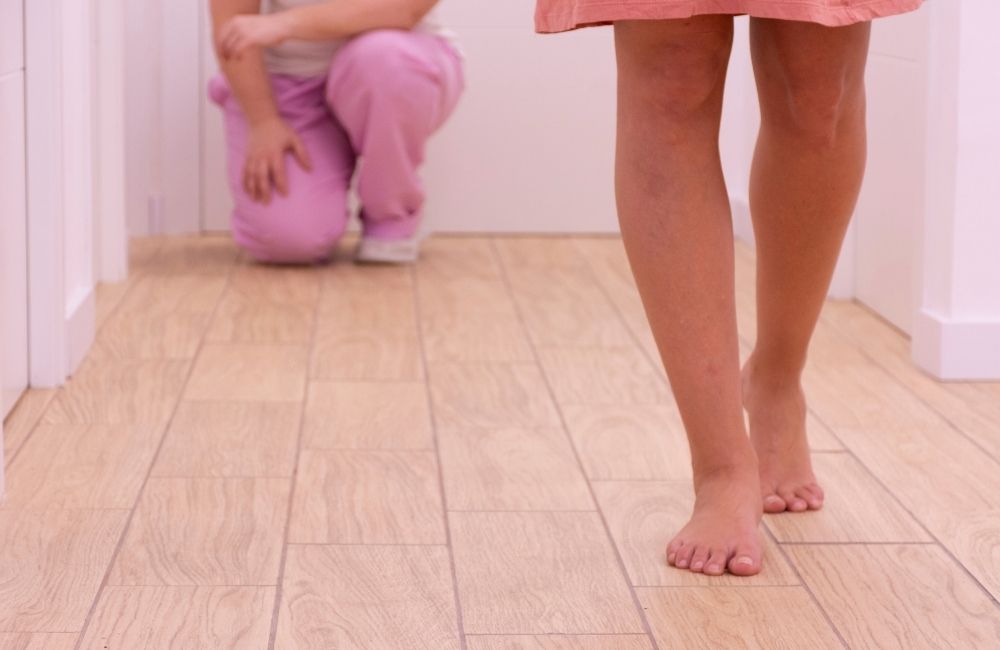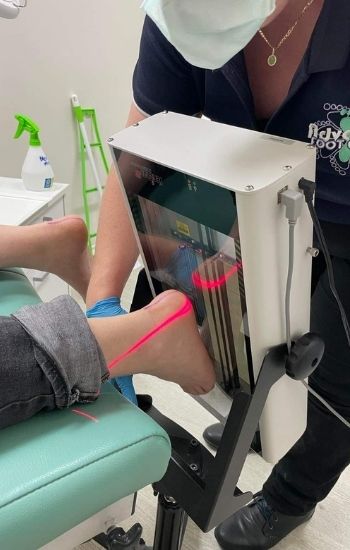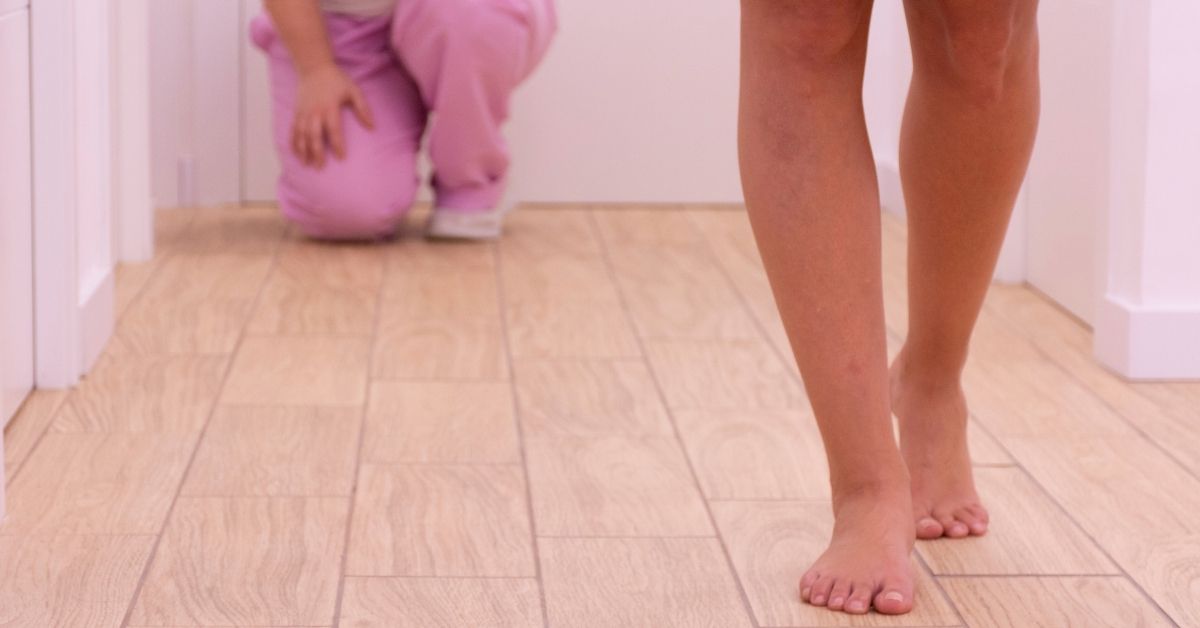Wondering about what’s involved in getting a pair of orthotics? Let’s step through the process and hopefully answer some common questions you may have about getting custom orthotics.

Step 1 – Determine the need and suitability for custom orthotics
Often your podiatrist will recommend custom orthotics during the course of your treatment. This means your podiatrist already has a good idea of why and how custom orthotics can help you. The podiatrist will need to assess the footwear you have to determine which is and isn’t suitable for custom orthotics. They will usually work with you to select one or two pairs of shoes that your first set of orthotics will be designed for.
Don’t already see a podiatrist and think custom orthotics may benefit you? Book an initial consultation with one of our friendly podiatrists for an assessment of your needs.
Step 2 – Biomechanical assessment
If you proceed with getting custom orthotics, the next step is to book a ‘biomechanical and scan’ appointment. This will take approximately 40 minutes. At this appointment your podiatrist will look at the position and motion of the joints in your feet, legs and hips. A visual gait analysis is used to identify any abnormalities to be corrected and controlled in your orthotic prescription.
For this appointment it is important to wear unrestrictive comfortable clothing which allows for easy visualisation of your feet and knees. Clothing should not interfere with any of the movements of your body. Your podiatrist will be assessing your body’s range of motion at multiple joints, including the hips. Sportswear is ideal. Skirts, tight pants or overly thick/baggy clothing will make these assessments harder.
Step 3 – 3D Laser scan
This step will usually occur at the same appointment as the biomechanical assessment described in step 2. Your podiatrist will need to draw a couple of marks on your foot to help with 3D scan, but may choose to mark other locations, such as the location of a bony section or where they want certain adjustments to go.
You will then need to lie still while we capture a 3D scan of your feet. This takes approximately 30 seconds per foot. Your podiatrist may hold your foot in position during the scan. Once this is done, the software will display the captured 3D images which we will check for accuracy and positioning. These images are used by the orthotic lab to create your unique orthotics.

Step 4 – Orthotic prescription
Following your ‘biomechanical and scan’ appointment, the podiatrist will use both the 3D scans and the biomechanical assessment findings to complete a suitable orthotic prescription. We complete this electronically and send it directly to the manufacturing lab along with the 3D image file. To aid your podiatrist in completing a good prescription, please bring the shoes the orthotics will be going into with you to the biomechanical and scan appointment.
Step 5 – Orthotic manufacture
We send our prescriptions to a respected and skilled orthotic lab in South Australia called ‘CadCam Orthotics.’ An experienced team of lab technicians will make, hand-finished and quality check your orthotics. To ensure a great final product, the lab technician and prescribing podiatrist will chat to confirm prescription details.
Step 6 – Orthotic dispense appointment – collecting your custom orthotics
Approximately 1-2 weeks after sending off your prescription, the completed orthotics will arrive at the clinic ready for dispense into your footwear. Your podiatrist will shape and fit the orthotics into your agreed upon footwear, and make any minor adjustments needed to ensure comfort. We will give you wearing-in instructions and make a follow-up review appointment.
Step 7 – Wearing-in
For the first month following getting your orthotics, you will go through a gradual wearing-in of the devices as per your podiatrist’s instructions. It is important to not rush the process and follow these wearing-in instructions carefully in order to get the most out of your orthotics. By the end of the four week period, you should be seeing benefits and be able to wear your orthotics comfortably all day. If you still feel minor discomfort, do not be discouraged – this is one of the reasons we always make a review appointment!

Step 8 – The 1 month review appointment
This step is essential. After one month, the general ‘new-orthotic’ adjustment period should be completed. So now we can identify and fix any problems with your orthotics which are likely to persist long-term. This appointment gives your podiatrist an opportunity to reassess your posture and gait after your body has adjusted to the orthotics. Your podiatrist will make any further adjustments to optimise their efficacy. The podiatrist will recommend the appropriate time for your next review, though it is generally at 6 months.
Step 9 – Your second set of custom orthotics
Once you and your podiatrist are happy and see progress, you might wish you had orthotics in all your shoes. Sometimes orthotics fit easily into multiple pairs of shoes but often the style and fit is too varied. To avoid compromising the integrity of the orthotic, the podiatrist must complete another prescription. This is where getting a second pair of orthotics can come in handy. For example, many patients have orthotics in their athletic shoes and a pair in their work or everyday shoes.
If it is within one year since your first orthotics, it’s possible we can arrange a second set at a discounted price. This will often be without doing a new ‘biomechanical and scan’ appointment. Just bring the shoes you would like an additional set of orthotics fitted into to your podiatrist. They will then complete a new orthotic prescription for you.
Step 10 – Ongoing monitoring
A number of factors affect the lifetime of orthotics. These include activity levels, footwear, materials, whether the feet have grown and how they are cared for. It is important to monitor your orthotics for signs of deterioration before they cause an issue with your initial foot problem. We generally recommend reviewing orthotics at least once a year with your podiatrist. This makes sure we catch any issues before you start experiencing problems from your orthotics no longer working well.


